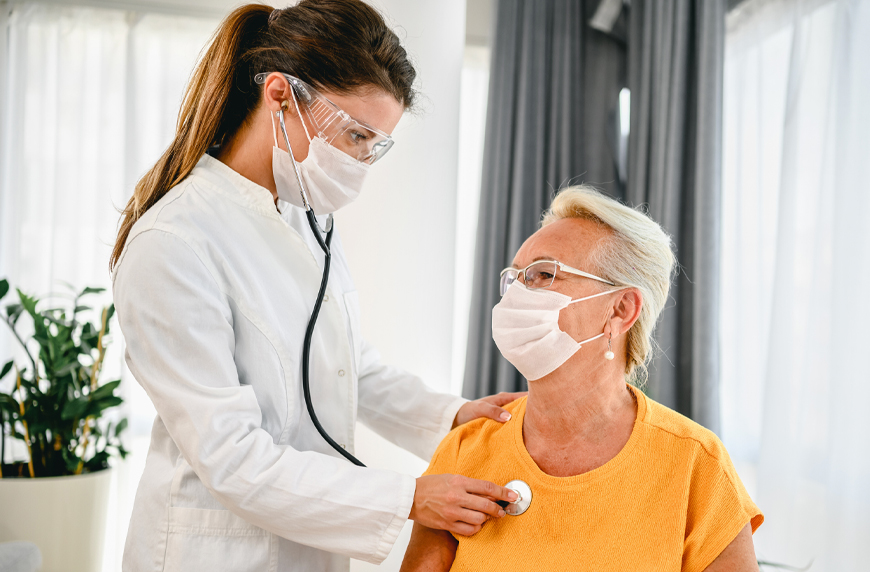
When the pandemic began in early 2020, healthcare providers had to make a lot of changes — not only learning how to care for COVID-19 patients, but how to keep themselves and non-COVID patients safe as well. Advanced practice providers (APPs) like physician assistants (PAs) and nurse practitioners (NPs) played an important role in helping healthcare organizations to manage the crisis. Here are four key takeaways from the pandemic about APPs, and how their skills may be the key to expanding access to quality patient care post-pandemic, too.
1. APPs’ transferrable skills improved the pandemic response
A central tenet to NP and PA training is learning clinical skills that are transferrable across multiple settings. These skills became especially useful during the pandemic, as many PAs and NPs were redeployed to work in the practice settings that needed their help the most. Both professions had a strong presence on the pandemic frontlines, with 61% of NPs and 50% of PAs reporting they’ve tested, diagnosed, or treated COVID-19 patients over the past year.
“Since PAs are trained as medical generalists, we’re experienced with treating the whole patient with a variety of medical and surgical problems across their lifetime. This flexibility gives us the skill and ability to move toward areas in need, especially during a national health crisis,” says Jennifer Orozco, MMS, PA-C, DFAAPA, director of advanced practice providers at Rush University in Chicago.
Denisha Pierman, PA-C in emergency medicine, says she worked in a variety of environments throughout the pandemic. “You had to be able to go with the flow of what you were needed to do at the time, whether it be triage outside in the tents or seeing patients inside in a full COVID unit in full gear. I was flexible in whatever role they needed me for each day,” she says.
Likewise, NPs were redeployed to help in various settings, says Sophia Thomas, DNP, APRN, FNP-BC, PPCNP-BC, FNAP, FAANP, president of the American Association of Nurse Practitioners. “Throughout the pandemic we’ve seen NPs diagnosing and treating patients in their primary care setting, staffing ICUs in hospitals, testing patients from mobile units, and now taking vans into rural communities to be sure underserved communities are vaccinated,” she says.
2. Emergency regulatory changes for APPs improved patient access
One reason PAs and NPs were able to quickly move between care settings was due to changes to scope of practice (SOP) laws.
Prior to the pandemic, the ability that PAs and NPs had to practice to the full extent of their training depended on where they lived. In some states, APPs can only practice under the supervision of a collaborating physician, while others do not have these requirements. During the pandemic, many states relaxed their scope of practice laws, allowing NPs and PAs to care for patients with more autonomy.
In states where restrictions were temporarily relaxed, “it gave healthcare systems the flexibility to leverage NPs to their full capacity,” says Thomas. “I practice in Louisiana which was one of the states that suspended the requirement for NPs to have a collaborative practice agreement, and NPs in Louisiana were able to volunteer and practice in other areas without any barriers.”
3. Expanding the APP scope of practice has multiple benefits
This temporary scope of practice expansion has shown that allowing APPs to practice to their full capacity is a way to address healthcare staffing shortages and increase access to care.
However, a year into the pandemic, no firm timelines have been established for an end to many emergency scope of practice measures, leaving PAs and NPs unsure about what comes next. Many APPs may not wish to return to their pre-pandemic roles, and this could adversely affect their job satisfaction and well-being, according to Health Affairs.
One solution to this problem is to advocate for permanent changes. Thomas says she’s advocating for a proposal to update NP practice laws in Louisiana. “If over the last year NPs have been safe enough to practice through a pandemic where the need is greatest,” she says, “then we should be able to practice where the need is greatest all the time.”
“It’s about access to care,” she continues. “COVID-19 has shed a spotlight on the fact that there’s a lot we can do differently. Having all healthcare providers practicing at the top of their education and training without regulatory barriers will really improve healthcare access. Licensure reform is a bipartisan way to advance our healthcare system.”
4. Strategic deployment of APPs can strengthen your organization
Regardless of what regulatory changes occur, healthcare organizations can leverage the unique strengths of PAs and NPs to ameliorate staff burnout and increase patient care.
Thomas says respect and acknowledgement can go a long way. “Treat us as a respected part of the healthcare team and recognize our value and impact on healthcare,” she says. “NPs are dedicated to patient education. We’re known for spending extra time with patients — listening to them and making sure they understand their diagnosis. We know that when we do that, they’re more likely to have successful outcomes.”
Pierman loves her job as a PA, and she’d like to educate more people on what the PA profession is and what their capabilities are. “It doesn’t mean you’re getting less care,” she says. “I’ve had a number of patients tell me, ‘My primary care provider is a PA and I love them. They spend more time with me than my physician would.’”
With a growing physician shortage, utilizing PAs and NPs to the full extent of their education is a smart strategy that can allow your facility to provide quality care to more patients. “It’s all about good outcomes, healthy patients, and improving access,” says Thomas.
This article first appeared on CompHealth.com. CompHealth is a division of CHG Healthcare. For help finding the physicians and advanced practice providers you need to staff your healthcare facilities, give us a call at 866.588.5996 or email ecs.contact@chghealthcare.com.